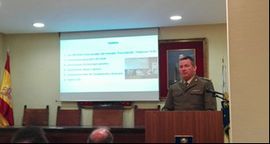- Home
- 'Boletín Tierra' Newspaper Reports
- Taller cero de material de campamento y equipo
Encampment material and equipment
Friday, May 3, 2019
Number: 01

Carrying out the workshop
Last Thursday (15th of November), Workshop ‘0’, focussing on encampment material and equipment, took place in the Park and Centre of Supply and Logistics facilities. This workshop is an activity which is included within the BRIEX 2035 concept, and attempts to continue the Army Forum which was held in the Army Museum in 2018. The main objective is to find a meeting point between the companies related to Defence and the Army, in order to facilitate a two-way exchange of information (beyond that which is contractually required) regarding the Army Staff’s future needs and what the businesses can achieve. The Army’s Logistical Support Command (MALE, to use its Spanish acronym) is acting as a catalyst.
The activity was called ‘Workshop 0’ and was focussed on encampment equipment. This workshop will be followed by others which are sectoral in nature, and which will focus on certain capabilities and serve as preparation for the next annual forum in October.
To encourage the exchange of information, various presentations were given by the Logistical Division, whose representative made a forecast about Logistical Support, highlighting the two big challenges: the reduction of the logistical footprint and the need for training to create more staff who are able to ‘multiply’ and carry out not just one task, but many, which would require them to have excellent training.
The Directorate of Acquisitions stressed that the Army has highlighted that the new Force 35 concept implies the ‘integral’ acquisition of the capacities which make up a Brigade. Furthermore, they have emphasised the need to plan for and think about the time left until the Army’s attainment of Force 35, since the tasks which have been assigned to the Army will continue to be very demanding in situations which are changeable, and to continue thinking about conduct across the full spectrum of conflict. Later it addressed trends and improvements in different capabilities and equipment: production and purification of water, power generators, waste management, air-conditioning units, containers, multi-purpose tents, clothing for extremely cold conditions, as well as technological challenges relating to Remotely Piloted Aircraft Systems (RPAS) and Robotics and Autonomous Systems.
During the debates they delved deeper into the companies’ needs to recognise and identify the medium and long term trends in relation to the assigned material. This will be necessary for the Army in order to direct the expensive resources which are required for research and development. They discussed the companies’ commitment to giving the best material resources to the Army, a commitment which goes beyond the mere legal business benefit which is, of course, also required.
To end the workshop the Army’s Director of Acquisitions reminded those present of the need for both businesses and the Army to ‘look forward’ and think about equipment which will be necessary in the future. Although this will be complicated, it is essential in order to meet the objective of providing the units with the best equipment with which they can carry out their missions.
ARMY UNITS
- Araba Álava |
- Albacete |
- Alicante |
- Almería |
- Asturias |
- Ávila |
- Badajoz |
- Barcelona |
- Burgos |
- Cáceres |
- Cádiz |
- Cantabria |
- Castellón |
- Ceuta |
- Ciudad Real |
- Córdoba |
- A Coruña |
- Cuenca |
- Girona |
- Granada |
- Guadalajara |
- Gipuzkoa |
- Huelva |
- Huesca |
- Islas Baleares |
- Jaén |
- León |
- Lleida |
- Lugo |
- Madrid |
- Málaga |
- Melilla |
- Murcia |
- Navarra |
- Ourense |
- Palencia |
- Las Palmas |
- Pontevedra |
- La Rioja |
- Salamanca |
- Segovia |
- Sevilla |
- Soria |
- Tarragona |
- Santa Cruz de Tenerife |
- Teruel |
- Toledo |
- Valencia |
- Valladolid |
- Bizkaia |
- Zamora |
- Zaragoza



